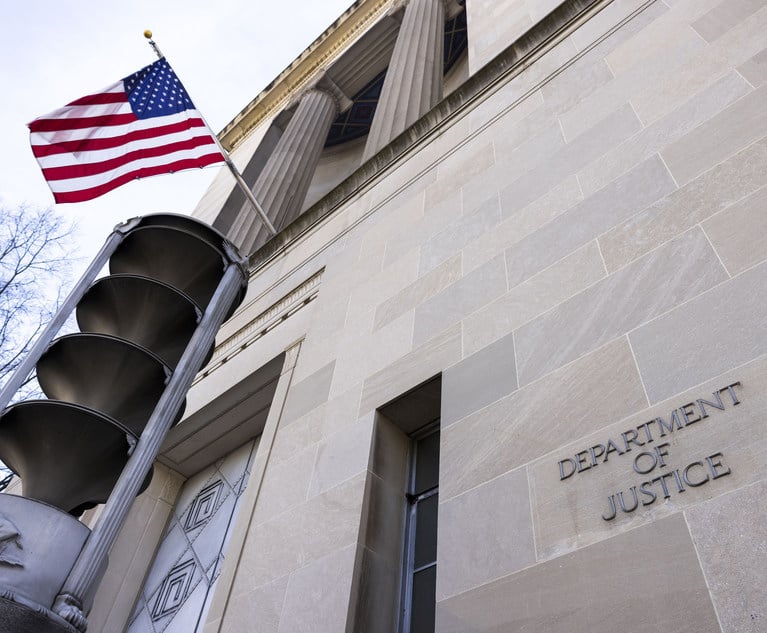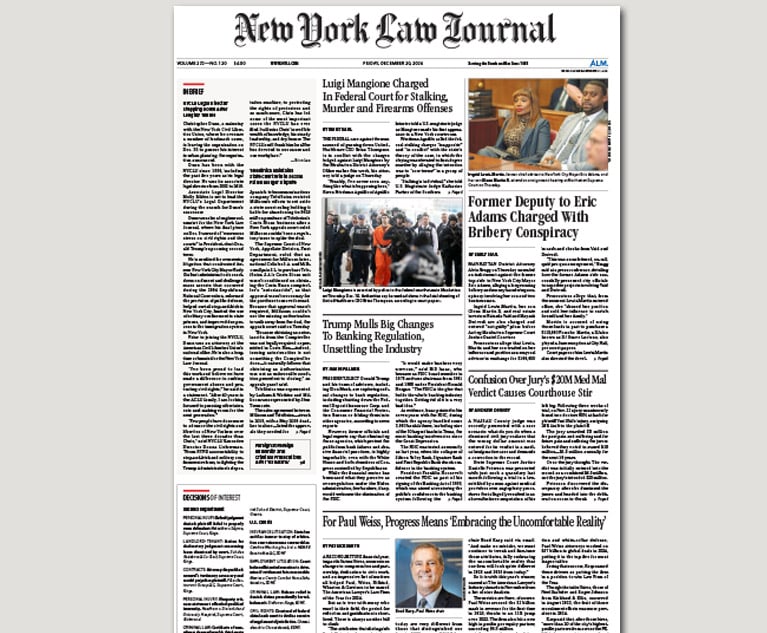Review of Developments Under State Environmental Quality Review Act
In their column on Environmental Law, Michael B. Gerrard and Edward McTiernan review the decisions issued by New York courts in 2017 under SEQRA.
July 11, 2018 at 02:45 PM
3 minute read
 |
|
Revised Regulations
- Green infrastructure upgrades or retrofits;
- Installation of solar arrays on closed landfills, cleaned-up brownfield sites, wastewater treatment facilities, and sites zoned for industrial use, or solar canopies on residential and commercial parking facilities;
- Installation of solar arrays on an existing structure not listed on the National or State Register of Historic Places;
- Reuse of a residential or commercial structure, or structure containing mixed residential and commercial uses;
- Acquisition and dedication of parkland;
- Land transfers in connection with one, two or three family housing; and
- Construction and operation of certain anaerobic digesters at operating publicly owned landfills.
Cases
Friends of P.S. 163 v. Jewish Home Lifecare, Manhattan
- The Appellate Division, Second Department ordered the preparation of a supplemental EIS to assess the presence of wetlands on the site of a housing development in the Town of Ramapo, where the town planning board had relied on a 2007 letter from the Corps of Engineers about a smaller project rather than requiring a new jurisdictional determination from the Corps. Shapiro v. Planning Board of the Town of Ramapo, 155 A.D.3d 741 (2d Dept. 2017). A separate decision required a supplemental EIS for that project concerning the impacts of placing the homes in close proximity to a natural gas pipeline. Youngewirth v. Town of Ramapo Town Board, 155 A.D.3d 755 (2d Dept. 2017).
- Ramapo was keeping the Second Department busy, and the court affirmed the nullification of the approval of a commercial development straddling the Towns of Ramapo and Haverstraw because there had not been consideration of whether a supplemental EIS was needed in view of the addition of a 16-pump gasoline station to the project. Green Earth Farms Rockland v. Town of Haverstraw Planning Board, 153 A.D.3d 823 (2d Dept. 2017).
- The Fourth Department annulled a negative declaration for a supermarket in Rochester, where the presence of soil contamination on the site had been ignored. Rochester Eastside Residents for Appropriate Development v. City of Rochester, 150 A.D.3d 1678 (4th Dept 2017).
- The Supreme Court for Seneca County required the preparation of an EIS for a local law adopted by the Town of Seneca Falls that would allow an existing solid waste landfill to stay open, despite an earlier law requiring its closure. Waterloo Contractors v. Town of Seneca Falls Town Board, 2017 NY Misc. Lexis 3540 (Sup. Ct. Seneca Co. Sept. 13, 2017).
- The Supreme Court for Broome County vacated the site plan approval and negative declaration for a natural gas compressor facility in the Town of Fenton near a public park and near an intersection needed for access to a school. Chenango Valley Central School District v. Town of Fenton Planning Board, 2017 NY Misc. Lexis 3243 (Sup.Ct. Broome Co. Aug. 28, 2017).
- The Supreme Court in Suffolk County required the preparation of a supplemental EIS for a townhome development in Southampton to consider whether there was adequate water supply. Shinnecock Neighbors v. Town of Southampton, 55 Misc. 3d 1224(A), 61 N.Y.S.3d 193 (Sup. Ct. Suffolk Co. 2017).
Mutual Aid Association of the Paid Fire Department of the City of Yonkers v. City of Yonkers Michael B. Gerrard is a professor and director of the Sabin Center for Climate Change Law at Columbia Law School, and senior counsel to Arnold & Porter. Edward McTiernan , a partner in Arnold & Porter, is a former general counsel of the New York State Department of Environmental Conservation.
This content has been archived. It is available through our partners, LexisNexis® and Bloomberg Law.
To view this content, please continue to their sites.
Not a Lexis Subscriber?
Subscribe Now
Not a Bloomberg Law Subscriber?
Subscribe Now
NOT FOR REPRINT
© 2024 ALM Global, LLC, All Rights Reserved. Request academic re-use from www.copyright.com. All other uses, submit a request to [email protected]. For more information visit Asset & Logo Licensing.
You Might Like
View All
'So Many Firms' Have Yet to Announce Associate Bonuses, Underlining Big Law's Uneven Approach
5 minute read
Government Attorneys Are Flooding the Job Market, But Is There Room in Big Law?
4 minute read
T14 Sees Black, Hispanic Law Student Representation Decline Following End of Affirmative Action
Trending Stories
- 1Life, Liberty, and the Pursuit of Customers: Developments on ‘Conquesting’ from the Ninth Circuit
- 2Biden commutes sentences for 37 of 40 federal death row inmates, including two convicted of California murders
- 3Avoiding Franchisor Failures: Be Cautious and Do Your Research
- 4De-Mystifying the Ethics of the Attorney Transition Process, Part 1
- 5Alex Spiro Accuses Prosecutors of 'Unethical' Comments in Adams' Bribery Case
Who Got The Work
Michael G. Bongiorno, Andrew Scott Dulberg and Elizabeth E. Driscoll from Wilmer Cutler Pickering Hale and Dorr have stepped in to represent Symbotic Inc., an A.I.-enabled technology platform that focuses on increasing supply chain efficiency, and other defendants in a pending shareholder derivative lawsuit. The case, filed Oct. 2 in Massachusetts District Court by the Brown Law Firm on behalf of Stephen Austen, accuses certain officers and directors of misleading investors in regard to Symbotic's potential for margin growth by failing to disclose that the company was not equipped to timely deploy its systems or manage expenses through project delays. The case, assigned to U.S. District Judge Nathaniel M. Gorton, is 1:24-cv-12522, Austen v. Cohen et al.
Who Got The Work
Edmund Polubinski and Marie Killmond of Davis Polk & Wardwell have entered appearances for data platform software development company MongoDB and other defendants in a pending shareholder derivative lawsuit. The action, filed Oct. 7 in New York Southern District Court by the Brown Law Firm, accuses the company's directors and/or officers of falsely expressing confidence in the company’s restructuring of its sales incentive plan and downplaying the severity of decreases in its upfront commitments. The case is 1:24-cv-07594, Roy v. Ittycheria et al.
Who Got The Work
Amy O. Bruchs and Kurt F. Ellison of Michael Best & Friedrich have entered appearances for Epic Systems Corp. in a pending employment discrimination lawsuit. The suit was filed Sept. 7 in Wisconsin Western District Court by Levine Eisberner LLC and Siri & Glimstad on behalf of a project manager who claims that he was wrongfully terminated after applying for a religious exemption to the defendant's COVID-19 vaccine mandate. The case, assigned to U.S. Magistrate Judge Anita Marie Boor, is 3:24-cv-00630, Secker, Nathan v. Epic Systems Corporation.
Who Got The Work
David X. Sullivan, Thomas J. Finn and Gregory A. Hall from McCarter & English have entered appearances for Sunrun Installation Services in a pending civil rights lawsuit. The complaint was filed Sept. 4 in Connecticut District Court by attorney Robert M. Berke on behalf of former employee George Edward Steins, who was arrested and charged with employing an unregistered home improvement salesperson. The complaint alleges that had Sunrun informed the Connecticut Department of Consumer Protection that the plaintiff's employment had ended in 2017 and that he no longer held Sunrun's home improvement contractor license, he would not have been hit with charges, which were dismissed in May 2024. The case, assigned to U.S. District Judge Jeffrey A. Meyer, is 3:24-cv-01423, Steins v. Sunrun, Inc. et al.
Who Got The Work
Greenberg Traurig shareholder Joshua L. Raskin has entered an appearance for boohoo.com UK Ltd. in a pending patent infringement lawsuit. The suit, filed Sept. 3 in Texas Eastern District Court by Rozier Hardt McDonough on behalf of Alto Dynamics, asserts five patents related to an online shopping platform. The case, assigned to U.S. District Judge Rodney Gilstrap, is 2:24-cv-00719, Alto Dynamics, LLC v. boohoo.com UK Limited.
Featured Firms
Law Offices of Gary Martin Hays & Associates, P.C.
(470) 294-1674
Law Offices of Mark E. Salomone
(857) 444-6468
Smith & Hassler
(713) 739-1250







